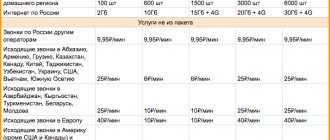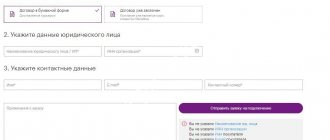Wireless GSM alarms have gained enormous popularity in just a couple of years among owners of country houses, small industrial premises, apartments, shops and garages. For the correct functioning of such security systems, you need a SIM card from a reliable mobile service provider. It is precisely the correct choice of SIM card for GSM alarms that determines the speed of operation of the system and the guarantee of sending alarm signals when security sensors are triggered.
Description of the "Mayak" tariff from MTS
The tariff plan called “Mayak” from the mobile operator MTS is a specialized offer for mobile gadgets. It differs from others in that it is not intended for calls, neither voice nor video. Access to these services is closed. Calls can only be made to emergency numbers. The main functions of Mayak are fax transmission, messaging and Internet access.
Each GSM security system simply must have a connection with its owner. Interaction is realized using SMS and fax notifications with specific commands. It is precisely for such purposes that a tariff plan with the interesting name “Mayak” was created. It is not too expensive and offers users a large SMS and data package.
- Internet access is charged per megabyte, because the provided data channels consume a tiny amount of traffic. If the owner still does not have enough megabytes provided, he will be able to order the “MiniBit”, “Bit” or “SuperBit” options.
- There is no mandatory subscription fee for using the tariff plan. Naturally, you will have to pay for packages of additional messages and megabytes every month.
- As already noted, Mayak does not provide unpaid minutes, messages or megabytes. To extend auxiliary Internet access packages, it is recommended to use the “Turbo button”. This is the only way to return high-speed Internet traffic.
Additional Information
To learn more about the tariff plan, let’s look at the most frequently asked questions online:
How to disable the Internet of Things option?
The user can disable the Internet of Things tariff from Megafon or replace it with another at any time on the official Megafon website. To stop cooperating with a company, you must terminate the contract by contacting the post office or sending a notice in writing.
Who is the tariff suitable for?
The offer is indispensable for companies with a developed computer network. It is effectively used by companies in the transport industry and banking sector, housing and communal services.
What to do if you can’t activate the tariff?
You must contact the company's employees at 0555 or 8-800-550-05-55. For questions regarding payment and contract management, you can write to
Features of using trackers
The accuracy of the received data on GPS coordinates of trackers depends on the system they are served by, or rather, on the number of satellites involved in positioning. Data with an accuracy of 1 m is provided by platforms that use at least 9 satellites to determine location. MTS uses a two-position system that simultaneously uses satellites of the GLONASS and GPS systems.
The tracker was not originally designed for private use. These services became popular with the advent of personal devices. Most often, these devices are installed in a car for satellite monitoring of transport using cellular communications.
The advantage of the MTS mobile navigation method in Russia:
- obtaining accurate two-position data even at points of uncertain reception;
- the ability to install any receiving module with GPRS support;
- control is implemented using a supported SIM card, and commands are transmitted via SMS.
Please pay attention to changes in the cost of services in Russia, as well as the conditions for receiving and sending SMS in the package you are using. Using the MTS tariff for the Mayak navigator, traffic jams are determined and transmitted to the navigation device, which allows the driver to find out the location of a problematic traffic intersection long before approaching them
Even when using this option, the amount of Internet required for navigation does not exceed 10 MB/month.
Features of price formation
This plan is not available in some regions. Additionally, program conditions may differ from those indicated. How can I find out the current indicators?
- Go to the operator's website.
- The location is automatically determined.
- You can correct the data if the region is specified incorrectly.
- Select the tab with tariffs.
- Find the Signal in it.
- Open the page and familiarize yourself with the parameters.
Indicators depend on the economic situation in the region and competitors’ offers. Therefore, companies often adjust the terms for various entities to make their plans as beneficial as possible.
Price
The cost of services depends on your region, but usually is no more than 3 rubles per day
. Thus, for users from Moscow and the Moscow region, a subscription fee of 1 ruble per day is charged. Residents of St. Petersburg, Leningrad region, Tambov, Lipetsk, Orel, Voronezh will pay 3 rubles for daily tariff service.
The transition to the tariff and the connection itself are free. However, according to the company’s rules, you can change your tariff plan for free no more than once a month. This also applies to the “Signal” tariff, because otherwise the cost of connection will be at least 150 rubles.
Cost of services:
- one megabyte of Internet traffic costs 2 rubles;
- calls within the Beeline network and to numbers of subscribers of other cellular companies - 50 minutes per month free of charge, after using up the included volume of minutes the cost will be 3 rubles/min;
- 50 SMS and the same number of MMS included; when the package is exhausted, we pay 3 rubles per message;
- the cost of telephone calls when roaming (CIS countries, Georgia, Ukraine) is 55 rubles, in Europe, the USA, Canada - 70 rubles, in other countries at least 100 rubles.
- switching to the tariff and servicing a “beautiful room” is free.
Cost and tariff conditions
In the overall picture, the conditions and prices on the tariff plan look like this (for Moscow and the region):
- Voice calls to MTS within the home area – 1.5 rubles per minute.
- Calls to other telecom operators in your home area - 3 rubles per minute of communication.
- Calls to MTS phones to other regions of the country - 5 rubles per minute.
- Calls to other operators outside your area - 14 rubles for every minute of conversation.
- Internet access - each megabyte spent will cost 4.5 rubles.
- Sending SMS notifications in your home area – 1.5 rubles per piece.
- Sending SMS to other regions – 1.8 rubles for each notification.
- Sending text notifications outside the country – 5.25 per SMS.
An interesting fact is that under such conditions of use, the subscription fee for the tariff is 0. Naturally, many users will refuse conditions where they have to pay for access to the network and sending SMS. On other tariffs they are provided for a fixed monthly fee. But “Mayak” was not created for ordinary phones. For high-tech systems such as “Smart Home” and “GM Alarm”, it will be an ideal option.
Main manufacturers
There are three leading manufacturers in the GSM alarm market. These are StarLine, Pandora and Prizrak.
StarLine
The manufacturer StarLine entered the domestic market in 2013 and in a short time took a leading position. Today the company produces several series of devices:
- “E” series – alarms without a built-in GSM module, but with the possibility of self-installation;
- series “A” – the ability to control from a mobile phone and a more modern key fob;
- “B” series – has a GPS monitoring function and is characterized by increased immunity from interference;
- series “D” - similar to category “B”, but designed specifically for SUVs.
Communication with the module is carried out through the Telematika 2.0 mobile application.
Ghost
In the Ghost line of car alarms, devices with a GSM module can be identified by the first digit “8” in the model name (for example, 810, 820, 830 and 840). In addition to standard functions (microphones, remote control), Prizrak GSM devices are equipped with:
- CAN controllers responsible for reliable integration with automotive systems;
- PIN to drive function, which provides additional protection using a special code;
- sensors of external influences (shock, displacement, tilt, etc.).
Pandora
Pandora alarms have been produced since 2004 and meet all modern standards. Interestingly, it was this manufacturer that first introduced the possibility of authorization in the anti-theft system using a smart watch. The manufacturer provides motorists with a choice of devices with a wide price range.
An example of a car alarm configuration with a GSM module
If a car owner does not want to save money on protecting his car from theft, GSM alarms will be the right choice. The possibility of remote monitoring and control will allow you to prevent illegal use of the car in a matter of seconds. If the car was nevertheless stolen, the GSM module will allow you to determine its position with maximum accuracy. To ensure reliable operation of the device, you should purchase alarms only at dealerships or specialized stores.
Selecting a tariff for a GSM socket, GSM thermometer and GSM alarm
The devices presented in our range are controlled via a GSM channel. For this purpose, the devices are equipped with a cellular communication module and a slot for installing a mini-SIM SIM card (not to be confused with micro and nano). To ensure reliable operation of the device and reduce maintenance costs, you should choose a cellular operator and carefully select a tariff. But how to choose the right tariff and operator for your GSM device?
If the device is installed outside the countryside, then pay attention to the level of signal reception in the area. If the operator reception on your phone is problematic, ask your friends or neighbors nearby how they are doing with their reception
On the Internet you can find coverage maps of cellular operators or a map of base stations. Remember - a stable and strong signal level will allow the GSM device to notify you in time if an emergency situation occurs.
Thus, we have figured out the main nuances that are worth paying special attention to. Next, consider the current state of affairs among the proposed tariff plans
Review of tariffs for signaling with GSM
A modern alarm system is not just a device with an audible warning, but a complex software and hardware complex. It can not only turn on the siren when the lock is broken, but also track impacts, movements, infrared traces and other important parameters. And the most advanced systems notify the owner via SMS or “alarm call”. To implement this function, you need a device that supports a SIM card, as well as connected to the latest tariff for GSM signaling.
Should I choose Signal?
Before choosing an unusual tariff plan, we recommend that you carefully weigh the pros and cons. So, “Signal” will be the ideal solution if:
- in your home there are many devices (heating boilers, alarm and video surveillance systems, robotic vacuum cleaners, etc.) with a wireless Wi-Fi connection or the ability to control using a mobile network;
- you need a minimum of minutes, SMS and mms messages;
- you are satisfied with the daily subscription fee and the cost for individual services;
- Having an Internet speed of 128 Kb/sec suits you.
However, the tariff plan also has its drawbacks. Perhaps they will encourage you to choose this tariff only as an auxiliary one:
- small volume of services (no more than 50 minutes and SMS) included in the package;
- paid calls even within the network;
- high prices for roaming abroad;
- not valid in all regions (you can view the full list of available regions on the Beeline website);
- Internet at low speed.
Tariff selection rules
There are several major major ones operating in the Russian GSM communications market, as well as virtual operators using their capabilities. Each has its own tariff schedule with different conditions for the provision of services. They also offer special tariffs for “smart devices”, including GSM alarms.
When choosing a tariff, you should adhere to the following rules:
- no monthly fee or minimal fee. The alarm does not need to make long calls or use other services like various paid subscriptions. There is no need for a large package of SMS messages;
- low fees for outgoing SMS, and no fees for incoming ones. Short messages are key to the operation of the security systems that support them: with their help, the statuses of the sensors included in the system and the general condition of the protected object are sent to the owner. Therefore they must be profitable;
- cost of outgoing MMS. Multimedia functionality is generally less in demand, but some GSM alarms can take photos and videos of what is happening and send data to the owner’s smartphone. For owners of such systems, the price for MMS is an important parameter;
- free inbox. It is extremely rare to “ring” an alarm, and this feature is practically not needed. But the absence of incoming fees is offered by default on almost all plans today;
- minimum price for outgoing calls. Complexes with GSM support are capable of notifying the owner of the alarm system about events through a call - either a simple “ringing”, or a full one, with playback of a pre-recorded message. Therefore, the fee should be as low as possible. Well, if the operator provides, then the cost will be even less, or completely absent;
- work in conditions of zero and negative balance. It is not always possible to monitor the status of your mobile account and top up your balance on time, but the alarm system should work constantly. Therefore, so that at a crucial moment the notification is not blocked due to “zero”, you should find a tariff that allows sending messages even with it.
Fulfillment of these conditions will ensure efficient, profitable and uninterrupted operation of the security complex.
The following factors should be considered and paid attention to:
- type of alarm - car, home, office, as part of a “smart home” or separate;
- operating mode—what is the planned frequency of messages/calls;
- Are MMS messages necessary?
What is the essence of the “Signal” tariff?
The aforementioned Signal tariff from Beeline allows you to “control” all kinds of smart devices from a distance using SMS. If you have “smart” devices in your house, apartment or office, then you can regulate their operation using “Signal”. What exactly can be regulated?
- heating and meter readings;
- view online video of CCTV systems;
- alarm system;
- GPS devices.
Do you agree, it’s convenient?! This tariff, as you can see, is specialized, and this is its main advantage over all others. Therefore, it is not recommended to use it as a regular method of communication. Ideally, it is better to have two SIM cards in your phone, one of which works for communication, and the other is connected to the Signal tariff. But if you want to use this tariff on your main number, then there is no problem, because it also provides such an opportunity.
Cost of use
Tariffs are as follows:
- Daily write-off in quantity 1 rub.
as a subscription fee.
Total approximately 30 rubles
per month; - Incoming SMS and calls are free;
- Outgoing calls 5 rubles
per minute; - The cost of 1 MMS is 6.45 rubles
; - Messages within Russia – 2 rubles
, to other countries –
5.95 rubles
; - 1 MB of
Internet traffic costs
2 rubles
; - Calls to other regions – 5 rubles
.
These prices are valid in Moscow and the Moscow region. Costs in other regions of the country may differ from the above prices. You can ask any questions you may have from the Beeline operator by calling a short number 0611
. And also request details of the invoice to see if you are satisfied with the total cost of all servants.
Pros of the tariff plan
The tariff plan can be used by both individuals and legal entities. There are no restrictions. The tariff is very easy to connect, and it’s also quite simple to use. “Signal” will help you effectively manage all business issues of the office, even if you are currently away from it. It is convenient, when you are driving home, to turn on the heating in advance and go into an already warm apartment. Or if there is a nanny at home with your child, you can always see online what they are doing now.
Manage your time! By connecting to the "Signal" tariff plan from Beeline, you will save more than just a few hours - you will save energy for something more important!
The widespread development of information technology has led to the fact that more and more equipment that does not belong to the category of mobile devices, but is equipped with a slot for installing a SIM card, is appearing on sale. Such devices have the ability to transmit and receive various information using SMS or the mobile Internet. They find their application in providing comfortable conditions indoors, cars, houses, apartments and other real estate, as well as in monitoring the surrounding area.
This option is most often found in the following types of equipment:
- Heating boilers
- Water and gas meters
- Security Alarm Systems
- Video surveillance systems
- GPS devices
To control the operation of such devices at a distance, the Beeline operator has developed the “Signal” tariff. The service package is intended for use in M2M systems, which stand for “machine-to-machine communication systems.” This is a new generation technology that allows devices to exchange information or transmit it to other sources.
Smart tariffs for smart things
At your request, I dug into the tariffs for “smart things”, it’s really interesting. Even if you are not the happy owner of such a thing, one of these special tariffs may well come in handy in your household. For example, to the phone of a child or his grandmother.
A distinctive feature of such tariffs is their affordable price. Few “smart devices” eat traffic like crazy or chat with someone for an hour a day. Accordingly, the packages are modest and the prices are appropriate. And you and I know that it’s easy to choose an expensive tariff, but finding a cheap one is a quest. Yes, the law obliges the operator to have at least one tariff without a subscription fee, but such a tariff is the other extreme, although it is also a necessary thing. Some problem in the tariff “black hole” in the range from 0 to
200 rub./month. Tariffs without a monthly fee are not very suitable (they turn out to be expensive), package tariffs tend to ARPU of about 350 rubles. average. And where should a peasant go? In some scenarios, pretending to be a “smart thing” may not be a bad option.
MTS, Go-Smart tariff
The former Smart Things tariff was renamed Go-Smart. At first, I stepped a little and didn’t see that a special section “Tariffs for smart devices” was made for this tariff; I looked for “Show all tariffs” in the list. As a result, I found the tariff by searching and at the same time found out that on the MTS website the tariff search engine by name responds only to a complete match of the request with the name, which is not entirely correct. I knew the name, but I didn’t know which word was in which language, and it didn’t occur to me that there was also a hyphen in the name. Okay, you don't have to look that often. The description of the tariff on the website is here, but this is not the whole picture, the tariff is multifaceted. It is declared that if you buy a smart device at an MTS store, this Go-Smart will automatically determine the type of device and connect the optimal set of services. Grace, you don't have to think about anything. There are quite a lot of options, if you are interested, then study the special section of the site here. They offer several different promotion options when purchasing different smartwatches, from the most budget ones to a special tariff for pensioners for 250 rubles/month, if you pay for this option for the year at once - 1,590 rubles. for the first year (132.5 rubles/month). Ha, special rate for pensioners for 250 rubles. per month, and only subject to the obligatory purchase of a smart watch - it’s cheap! Especially compared to the “Social package” tariff for 150 rubles. in Beeline, to connect to which you don’t need to buy anything at all. By the way, the need of pensioners for smart watches (according to MTS, pensioners have such a need and this need is acute) raises my doubts. It seems to me that this is something like offering a goat to buy a button accordion at a discount. Consult with your grandparents and share your feedback in the comments. At the same time, you will delight the elderly with a conversation.
Options
Parameters of the universal Go-Smart tariff, which they offer to use with a smart device purchased NOT at an MTS store:
- Subscription fee 790 rub. for the first year of use (paid immediately), from the second year 90 rubles/month. For use in a video camera, there is a special unlimited option for video surveillance for 360 rubles/month.
- Internet traffic is 200 MB per month, valid throughout Russia, including in the K-Telecom and KTK-Telecom networks (Crimea). Important: rounding traffic to 1 KB, which is very correct, since smart things are characterized by a large number of short sessions. After the 200 MB package is exhausted, the Internet is not blocked, access is maintained at a speed of 64 Kbps. In relation to smart things, the Internet is virtually unlimited; if it is not a video camera, things do not need high speeds.
- The package includes 30 minutes to all Russian numbers and 100 SMS, also to all Russian numbers.
- The starter kit includes, by default, “Banning voice content” and “Banning SMS content”. I had no idea about the existence of the last two “prohibitions.” I always thought that MTS had one that blocks everything. But no, live forever and learn.
You can also switch to the tariff, the only “but” is that when switching, the option is a monthly fee of 790 rubles. for the first year (that works out to be 66 rubles/month) it is not automatically connected, but it can be connected manually. Interesting tariff, you will agree. It will be suitable for a child to always be in touch, and for a grandmother to cover all her modest mobility needs such as going to the store. And 66 and even 90 rubles/month is more than budget. Eldar likes to compare the prices of communication services with a certain number of cups of coffee, but here 66 rubles. A monthly subscription and one cup of coffee is not enough everywhere.
MegaFon, Smart Things tariff
At least you didn’t have to search here, in the advertisement of smart watches they give a link to the tariff, and in the general list of tariffs on the MegaFon website these “Smart Things” are present. The description of the tariff is here, and the evil woman is tormenting me. It’s similar, although a little cheaper, to the MTS tariff. 750 rub. per year (in MTS 790 rubles), 20 rubles. per week (in MTS 90 rubles per month). All parameters are given per week (so that there are no direct comparisons with a competitor?), but there are also important differences. In the end it looks like this:
- Monthly fee 750 rub. per year (optional), or 20 rub. per week, or 2,500 rubles. forever, pay once and forget. If you accidentally drown the SIM card along with the watch, then in the salon they will give you a new one according to your passport, no problem. If you drown with your whole body along with the smart watch on your hand, then you need to figure out the procedures for inheriting a number and personal account. Most likely, the good will not be lost. Unless, of course, your heir is not too lazy to give himself a headache with all the trips and papers/registrations. These 2,500 rubles are transferred to a bank card in rubles. (or their balance) will not be returned to him in any case. And by the way, what is considered the remainder? Subtract the years actually lived from the average life time according to Rosstat? Since connection?
- Mobile Internet throughout Russia is conditionally unlimited. After using up 60 MB in a week, the speed is reduced to 64 Kbps. It turns out exactly 260 megabytes per month (in MTS 200 megabytes). Rounding is also up to 1 KB, everything is fair here and there are no questions.
- Package included
43 minutes of calls to all Russian numbers per month, 30 minutes in MTS. SMS messages
87 per month, in MTS 100. Almost a complete coincidence, perhaps MTS just like round numbers.
Tele2, “Internet for Things” tariff
The tariff description can be read on the Tele2 website here. Another tariff for devices, but no longer a twin brother, the parameters are noticeably different. Although there is still a lot in common. Options:
- Subscription fee - 100 rubles. per month. Surprisingly, I didn’t see an option to pay with a good discount for a year in advance and/or a single amount forever on the website. Don't want money? Or, on the contrary, do they want to? I agree, 100 rubles. in modern times - a couple of loaves of bread, but we are confidently moving towards the fact that there are more and more “smart things” and pretty soon the majority of the active population of Russia will inevitably become the happy owners of these things. And the most active users of new products will be multiple subscribers, there are a lot of things! Paying 100 rubles per month for each smart thing can result in a rather large total amount. Personally, I think the option with a one-time payment of 2,500 rubles is prettier. until the end of your own life or the life of a smart thing, but this is a matter of taste. If we are talking about a child’s smart watch, then it is hardly worth hoping for a long and happy life for such a device, and a monthly subscription would be more reasonable. Below is a screenshot from the Tele2 website with the conditions for non-payment of a subscriber.
- The ban on content subscriptions is enabled by default on the tariff, which is good. We should probably all say a big thank you to the author of the long-standing material who made a fuss about smart gates, who willingly and happily subscribed to numerous mailings, including porn. The scandal was significant, and many media outlets laughed heartily.
- The 300 MB Internet package is valid throughout Russia, and it is conditionally unlimited; after the package is exhausted, it works at a speed of 64 Kbps. Traffic rounding up to 1 KB, just like our competitors. It is not possible to receive Internet packages within the tariff plan.
- The tariff package includes 30 minutes of calls to any phones in Russia and 100 SMS to any numbers in Russia. Calls to all numbers in Russia after the package of minutes has been exhausted for 1.95 rubles per minute, SMS to all numbers in Russia beyond the package also for 1.95 rubles. per piece.
- Keep in mind that if a smart thing is located outside of your home region for more than 30 days, the subscription fee increases by 100 rubles. That is, in our specific case it doubles.
In terms of package content, the Tele2 “Internet for Things” tariff is almost identical to the MTS “Go-Smart” tariff, but the price of the Tele2 tariff is higher, which looks unusual for Moscow.
"Beeline", tariff "For smart things"
There was no need to go to a fortune teller; at first glance, the tariff parameters were similar to the offers of fellow competitors. And what kind of special discrepancies could one hope to see in package tariffs priced up to 100 rubles? per month? Let me remind you that we are talking about Moscow, where the price of a regular “package” tends to be ARPU (about 350 rubles/month), but the tariff for smart things is a special case, no one in their right mind will pay 400-600 rubles. for the tariff for smart gates. Or even for a tariff for smart watches, which seem to be smarter than gates, although this is not a fact. So, look at the tariff description here (Moscow), features and main parameters:
- Subscription fee 99 rub. per month for the first three months - don’t miss out on a landmark discount! 99 rub. – only when ordering on the website, then the subscription fee is 100 rubles/month. An immediately sobering cold shower - the tariff is only for new connections. Well, or for those switching to Beeline from other operators. If there is not enough money to charge the monthly fee, then only free incoming calls remain, everything else is blocked. What's the big deal with a smart thing about incoming voice calls when everything else is blocked? This is known only to the Lord God and Beeline. But the Lord seems to be omnipotent, and Beeline has the right according to the law and successfully uses this right.
- Internet traffic is 500 MB per month, generous? Hmm, I wouldn't say, the devil is usually hidden in the fine print. Session rounding is 150 KB, which immediately turns this relatively generous 500 MB into small change, since smart things tend to eat traffic very little, but often. Rounding up every 2-3 kilobytes of useful traffic to 150 KB is cruel. After the main package is exhausted, additional traffic packages will be connected: 52 rubles. for every 100 MB until the main Internet package is updated. To receive the service without connecting additional packages at speeds up to 64 Kbit/s (for LTE at speeds up to 64 Kbit/s from the network to the subscriber and up to 4 Mbit/s from the subscriber to the network), you can dial the command 067 471 778 0 or *115 *230#. It is possible, if you know about it, yes. Did you personally know about this? Now you know, but in the “Smart Thing” category tariff you need to connect this by default. Moreover, a smart device may be geographically far from its owner. The Internet package is valid throughout Russia, at least thanks for that.
- Further in the tariff, everything is also not very fun. They give 30 minutes per month of calls strictly to local cell numbers, all other calls are 5 rubles per minute. Who among us vehemently criticized MegaFon for its tossing around with calls to all/only cell numbers? The 100 SMS package, which is rather lavish for a smart thing, is also valid only for local mobile numbers, all other SMS are 5 rubles. per piece.
In general, the Beeline version of the tariff for smart things is not very kind and looks like a mockery of the consumer who is too lazy to read beyond the first three lines of the description. Unfortunately, we, as well as throughout the world, are the majority of such consumers. I also have a version that Beeline set up this tariff according to the well-known “let it go” principle, without delving into the details at all and without bothering with anything. In any case, click on the beautiful “I want this tariff!” sign on the website. I wouldn't recommend it. Moreover, in Beeline we are talking about the mandatory purchase of a new number (switching to this tariff is impossible), and why do you need this dubious joy when there are other, more acceptable options from other operators?
Summary
Surprising as it may seem, the seemingly completely primitive “technical specifications” of purchasing a tariff for a smart thing ultimately requires attention and a certain thoroughness. Although a mistake in choosing will definitely not ruin you, the difference is 10-20 rubles. will not make any weather in a month. The trick is that you and I will have more of these things and soon there will be a lot more of them. And marketers are already calling this process of proliferation of smart devices the beautiful term “building a home ecosystem.” Operators, of course, will have to revise prices; the Internet for things should ultimately cost much less, and 100 rubles per month just for servicing a fitness bracelet is clearly too much. However, things are things, but these “small” things are the future, and I am planning an exciting tariff adventure for all cell phones with tariffs for smart things. As they say, “we’ll see.”
Source
We assemble a GSM alarm system with our own hands without an old mobile phone
There may be a situation when you don’t have an old mobile phone at hand, but you want to save money on a GSM alarm system. In this case, an Arduino board with a built-in microcontroller will help us. A distinctive feature of this board is its low price and functionality. In our example, we will use an Arduino Uno board, which costs approximately $4 (depending on modifications). For the basis of this example, we will take the article “GSM Home Alarm V1.0”, authored by Hugo Gomez. You can find this article on the official website www.arduino.cc of the Arduino project. To assemble our alarm system with our own hands, we will need the following components:
- the board itself with the Arduino Uno microcontroller;
- GPRS Shield V2.0 - GSM module;
- power supply at [email protected] ;
- ultrasonic distance sensor HC-SR04;
- connecting wires;
- bread board;
- SIM card.
The cost of all components of such an autonomous alarm system will be $35, which is still much cheaper than ready-made solutions. The operating principle of this alarm is based on the HC-SR04 ultrasonic sensor, which detects the difference in distance and sends a signal to the mobile phone. For example, if a person gets into the sensor’s measurement area, the sensor will record a distance less than the intended one and the Arduino Uno will send a signal to the mobile phone. The measuring length of this sensor is 4 meters and the viewing angle is 30 degrees. Thanks to these characteristics, the sensor can be used at home, in the garage and in the country.
To assemble this alarm, the first thing you need to do is install a SIM card in the GSM module.
You should also disable the PIN code on the SIM card in advance. Now let's connect all the components with wires according to the diagram shown below.
The assembled GSM alarm will look like this.
In order for our GSM module GPRS Shield V2.0 to work in conjunction with Arduino Uno, we will need to download the SIM900 library. You can download this library at this address https://www.gsmlib.org/download/GSM_GPRS_GPS_IDE100_v307_1.zip. After downloading, install this library. In a further step, we will need to open and edit the GSM.cpp file, which is located in a file in the SIM900 library folder. The fact is that the GSM module GPRS Shield V2.0 in conjunction with Arduino Uno uses pins 7 and 8. Therefore, open the GSM.cpp file and correct the values of lines 27 and 28 to:
Now we need to open the GSM.h file, which is also located in the library folder. In this file we need to comment out lines 20 and 45, and correct 8 to 9 in line 44.
We've sorted out the module, now we can go directly to our alarm code. The code itself can be downloaded from this link https://create.arduino.cc/code_files/47730/download. In line 11 of the code, you must replace “XXXXXXX” with the phone number to which the signal will be sent. By uploading the code to the Arduino Uno, you can test a standalone GSM alarm system. To do this, connect power to it and open the port monitor. The GSM module itself can take a long time to register in the network, where you will see the message “Waiting for Network Registration”. If registration in the network is successful, the alarm can be tested. To do this, move your hand over the operating area of the HC-SR04 sensor, after which you will see a message in the port monitor about the data taken from the sensor. In addition to messages in the port monitor, a call should be received to the phone specified in the code.
From the example it is clear that a person who has already worked with Arduino Uno can easily assemble a similar GSM alarm system with his own hands. In addition, such a warning system can be modified. For example, install several HC-SR04 ultrasonic sensors on it. You can also add an infrared sensor to this alarm system, the price of which in Chinese online stores starts from 50 cents. You can also add temperature sensors to this warning system, which will notify the owner of a house, garage or cottage in the event of a fire.
How to remove the speed limit on the “Signal” tariff from Beeline
A number of subscribers note that under this program the speed is limited to 128 kbit/s. This rule was introduced in the old versions of the plan, when there was unlimited traffic transfer.
The reason is the desire to limit the use of the Signal. The rule was introduced so that the subscriber would not be able to apply the tariff on his smartphone and view pages comfortably. Still, the company needs to sell other programs.
It is not possible to remove the speed limit. The fact is that the parameter is underestimated not in the case of traffic distribution, but in the tariff itself. No matter what you do, the maximum speed will remain the same until you change the plan itself.
How to choose
Of course, the best choice is all or most of the options listed above. Some of them are extremely useful, for example, the presence of a camera and MMS will allow you to identify an attacker, but the price of such a product is higher.
However, in most cases, the garage is limited to basic capabilities: sending SMS to several numbers, motion sensors, magnetic plus a powerful siren, light alarm.
Regarding detectors, their quantity: the user selects products to suit his conditions - for example, you can add thermal, smoke (fire) varieties, as well as any others.
The minimum that a high-quality GSM alarm system for a garage should have:
- signal protection;
- dialing more than 2 numbers;
- remote control (at least on/off) with key fobs. It’s good if there is an option to control from your phone;
- Powered simultaneously from mains and batteries. For sensors, small batteries are enough, since they are mainly in standby mode, the charge will last for a long time. But a battery is often used for the control unit, just like for a UPS. The ability to connect, including automatically, to the network is desirable, which will allow you to recharge batteries and save their charge;
- control off/on power supply, sensors, signal interruptions with SMS sending;
- clear, convenient control panel.
The modern market is oversaturated with GSM alarms; most model lines of brands in this niche have the above minimum. All of them, including domestic products, are in approximately the same quality range. The exception is frankly low-quality products, calculated based on user reviews. Often famous and not very recognizable brands use electronic hardware from the same manufacturers and similar software (for example, Arduino). Thanks to the introduction of methods to reduce the cost of production, prices are also not too different.
Online reviews
Reviews about the Internet of Things tariff plan are mostly positive. The advantages of the option include:
- the ability to connect to the M2M Monitoring service, which allows you to combine a network of software and hardware devices into a single ecosystem;
- fixation of monthly expenses for monitoring the movement of equipment;
- choice of one of six Internet packages (from 15 to 300 MB at a cost of 20 to 120 rubles);
- installing sensors in the most difficult places;
- low energy consumption.
Corporate clients are attracted by the opportunity to accurately plan costs with unlimited Internet for 100 rubles. A speed of 32 Kbps is enough to transfer data, for example, from water consumption meters.
Subscribers are confused by expensive outgoing calls. This tariff is not suitable for private clients. In general, the Internet of Things technology is an excellent option for institutions in various fields of activity, be it real estate, energy or logistics.
Connection
Note 3.
MegaFon subscribers can change their current package to “Warm Welcome” for free if the last transition from one product to another took place more than 30 days ago. Otherwise you will have to pay 100 rubles.
Important! If you are a subscriber of another operator, you can save your number when selecting MF.
To connect “TP” online
, need to:
- log in to your personal account on the website megafon.ru
(you can simply select your city without going into your profile if the purpose of visiting the resource is only to familiarize yourself with the offers); - select the “Tariffs and Services” category on the main page;
- select the “Tariffs” block and then – the “Mobile communications” subcategory;
- click the product name or click the “More details” link;
- Click on the “Select” button on the new page;
- select one of the options – “Buy a SIM card”, “Go to MegaFon” or “Change tariff”;
- enter the required data and confirm the action (the “Make an order”, “Start number porting” or “Get code” buttons, respectively).
In the event of a product change, everything will happen automatically if the opportunity itself is still available. Purchasing a new SIM card requires visiting a MegaFon store - it will be reserved from the moment you submit your application. The goods can also be delivered home by courier service (at the client’s request).
Important! When visiting the salon you will need to present your passport.
A similar procedure is implied when working with a mobile application.
There is only one nuance: by using MegaFon software, you are already a client of this operator. Therefore, changing the package is carried out remotely (if there is no need for a second SIM card).
How to connect and disconnect the Mayak tariff
It will not be possible to activate the presented tariff plan using traditional methods, such as sending a USSD request or dialing a service command. It can only be connected through a personal visit to an MTS communication salon, and then only by purchasing a new SIM card with a preset tariff.
Deactivating a tariff plan is also not available using conventional methods. This operation can only be performed using your personal account on the official website of the cellular company MTS.











